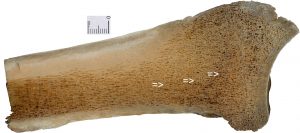Human remains have the ability to provide information even when all that is present is bones. After the start of the use of radiography, researchers were able to determine a line on the bone, invisible to the naked eye, that correlates with malnutrition or severe illness.
The Harris Line is a transverse layer on a long bone that shows a period of arrested development (right). Studies have shown this line appears on a bone not when physiological stress is present, but the time after when the individual is on their way towards better health, either by meeting their nutritional needs or recovering from an illness. The process of mineralization would have ceased during illness, and its resumption is when the line occurs.
Archeologists are able to use this information to determine if an illness or famine was present in an area. Should the majority of the remains show Harris Lines, it can be deduced that famine was present throughout a large area, and not necessarily a problem of one individual’s social status, or lack of means to acquire food. If the age of the remains can be deduced, researchers may be able to determine a more precise date of its occurrence. Furthermore, it is noted that childbirth can also be determined by the presence of Harris Lines, likely due to the fetus taking much of the mother’s vitamins and nutrients.
One study was done that focused on the differences between medieval Joseon and modern-day Korean samples. Researchers found that modern-day Koreans had a smaller percentage of adults with Harris Lines, and the instances where they did occur were nearly equal in both males and females. Joseon-age Koreans, however, showed Harris Lines at more than double the amount of modern-day. It was also noted that women were more likely to have a sign of malnutrition. While it was not explicitly stated, this could be due to pregnancy and breastfeeding after childbirth, both of which take vitamins and nutrients from the mother and pass them to the child.
In addition to having the ability to discover malnutrition in an area, archeologists can also use Harris Lines to unearth a rough estimate of population. According to a 2007 article by Neil H Metcalfe, Harris Lines may also appear on women’s pubic bones. These lines can help deduce the birth rate in the area and, when combined with annual death rates, may give a rough estimation of the population.
References
Beom, Jaewon, et al.
2014 “Harris Lines Observed in Human Skeletons of Joseon Dynasty, Korea.” Anatomy & Cell Biology, Korean Association of Anatomists, March 2014. Electronic document, https://www.ncbi.nlm.nih.gov/pmc/articles/PMC3968268/, accessed 4 October 2019.
Metcalfe, Neil H.
2007 “In What Ways Can Human Skeletal Remains Be Used to Understand Health and Disease from the Past?” Postgraduate Medical Journal, BMJ Group. Electronic document, https://www.ncbi.nlm.nih.gov/pmc/articles/PMC2600025/, accessed 3 October 2019.
Morgan, Matt A., and Daniel J Bell.
“Growth Arrest Lines: Radiology Reference Article.” Radiopaedia Blog RSS, Electronic document, https://radiopaedia.org/articles/growth-arrest-lines?lang=us, accessed 5 October 2019.
Piontek, Janusz & Jerszyńska, Blandyna & Nowak, Oskar.
2001 Harris lines in subadult and adult skeletons from the medieval cemetery at Cedynia, Poland. Variability and Evolution. 9. 33-43.
Images:
Figure 1: https://journals.plos.org/plosone/article/figure?id=10.1371/journal.pone.0196342.g003
Figure 2: https://www.semanticscholar.org/paper/Harris-lines-of-the-tibia-across-centuries%3A-a-of-in-Ameen-Staub/f8d3f81a57aecaa2e68f3725676f7a86bc9e782e/figure/3
Further Readings:
How to calculate the age of Harris Lines:
https://link.springer.com/article/10.1007/s12520-018-00773-5
Harris Lines as Stress Indicators
https://pdfs.semanticscholar.org/7cda/3af60037df6748cf6d7a49f1bf2ed7cbbc50.pdf



Why can studies of diet reveal about culture? Why is an understanding of a group’s diet important to understanding their culture?